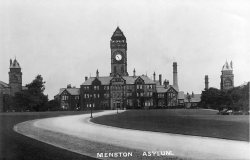Difference between revisions of "High Royds Hospital"
(Created page with "{{infobox institution | name = High Royds Hospital | image = highroyds3.png | image_size = 250px | alt = | caption = | established = 1885 | construction_began = | construction_...") |
m |
||
| Line 36: | Line 36: | ||
[[Category:England]] | [[Category:England]] | ||
| − | [[Category:Echelon Plan | + | [[Category:Echelon Plan]] |
[[Category:Closed Institution]] | [[Category:Closed Institution]] | ||
[[Category:Institution With A Cemetery]] | [[Category:Institution With A Cemetery]] | ||
Revision as of 23:24, 16 May 2014
| High Royds Hospital | |
|---|---|
 | |
| Established | 1885 |
| Opened | 1888 |
| Closed | 2003 |
| Current Status | Closed |
| Building Style | Echelon Plan (Broad Arrow) |
| Architect(s) | J. Vickers-Edwards |
| Location | Menston |
| Alternate Names |
|
History
High Royds Hospital, Menston was purchased between 1882 and 1886 by the West Riding Quarter Sessions Magistrates. The site covered 300 acres. It was classified as a pauper asylum and opened in October 1888 with a capacity of 800 beds. In 1889 the West Riding County Coucil took over the running of the hospital. In 1912 responsiblity for the hospital passed to West Riding Mental Hospitals Board. This board ceased to exist in 1946 after the National Health Service Act and after 1948 was administered by hte Menston Group Hospital Management Committee. The capacity in 1948 was c.2500 beds. In 1964 the hospital became High Royds Hospital and in the 1974 reorganisation of the health service came under the control of Leeds Western Health District. At this time there were 1322 beds. The hospital was closed on 25 February 2003. Although this date is given in the High Royds book the final two wards, office, canteen etc did not close until June 2003. Patients were relocated to various community mental health units in the City of Leeds, in the three years leading up to its closure. These include The Becklin Centre in St James' Hospital and The Mount (hospital) in the city centre.
The administration building, which is Grade II listed,has an Italian mosaic floor in the main corridor, decorated with the Yorkshire Rose and some black daisies.The hospital once contained a library, a surgery, a dispensary, butchers, dairies, bakers, a sweetshop, an upholster's, a cobbler's, spacious grounds, a ballroom and even a railway. The patients lived in Nightingale wards (named after Florence Nightingale), rather than the individual accommodation found in the more recent mental health units. The hospital was for much of its life connected to the Wharfedale railway line by a dedicated spur connection. The hospital also had a burial ground at Buckle Lane opposite the main building with a small chapel.


